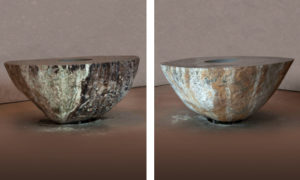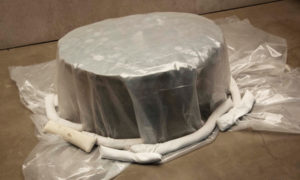Feb 18, 2020
The marvelous contemporary sculpture Tsukubai (2000), by Izumi Masatoshi, was inspired by traditional Japanese tsukubai, stone basins placed near the entrance to a tea house, temple or shrine, where visitors symbolically wash their hands before they approach a sacred building.
Masatoshi made the work from a Japanese basalt boulder cut in half; he polished the cross section by hand with water and abrasive stones for many months, until it achieved a mirror-like smoothness. Water pumped from below into the central well runs across the top and down the sides of the stone so smoothly and silently that it appears to be completely still.
Installed in our new building when we moved here in 2003, Tsukubai has sat quietly entrancing visitors in a contemplative nook in the Japan galleries. Recently, we noticed that is was also quietly growing algae. Algae had gradually covered the sides of the stone, leaving a slimy mess on the fingers of visitors who touched it.
It was at first unclear which department (curatorial, conservation or engineering) should be responsible for the upkeep of this contemporary sculpture with functioning plumbing. After some discussion, we decided conservation and engineering would work together to clean and maintain the work. It took quite a bit of searching to locate the original installation plans, which we found in the mountmaker’s shop; these showed the layout of the plumbing sealed under the floor. Meanwhile, research revealed that fountain/sculptures in other museums have had similar problems and how they were addressed.

First, we drained the entire system and flushed it thoroughly. Once the fountain was empty, we scrubbed it down, rinsed it, tented it in plastic and exposed it to alcohol fumes for 24 hours to kill any remaining algae.

The engineering department then installed an ultraviolet (UV) light sterilizer in the plumbing, so that the water is now constantly being sterilized as it circulates. They also installed a more convenient drain, so the water can be easily changed every two weeks.

Tsukubai is now back in operation and we are monitoring it regularly to make sure the algae doesn’t return.